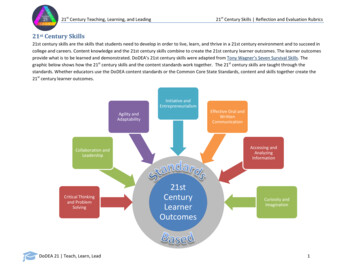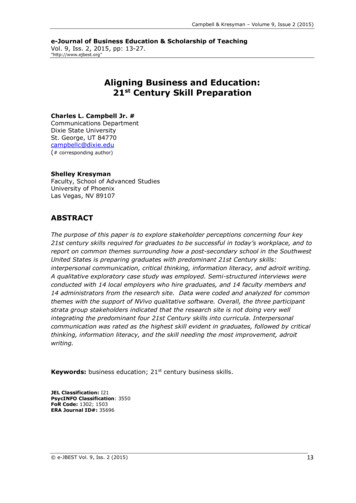
Transcription
Counterintelligencefor the 21st Century
Counterintelligencefor the 21st CenturyThe Intelligence and National Security Alliance (INSA) is pleased to present this paper oncounterintelligence (CI) to help frame the debate on an issue of high priority to US nationalsecurity. The paper was prepared with input from a broad range of INSA members, manyof whom had government careers in intelligence and law enforcement and now work forindustries that support the US national security mission.Several INSA members made contributions to this paper, but their individual inputs do notnecessarily connote agreement with all the judgments or recommendations in the document.The paper results from a lively debate that helped both to establish agreement on somecore issues—including the urgency of CI reform, the imperative to enhance offensive CI,and the need to clarify the role of CI in the era of globalization—but also to recognizedissent on others issues, especially with regard to the pace and scope of change neededto address the cyber and other technical challenges.The Director of National Intelligence (DNI) today faces continuing traditional national andtransnational threats while confronted, at the same time, by unprecedented technicalchallenges in the era of globalization. Getting ahead of these problems will requirefundamental, long-term reforms to CI governance, culture, and training across theIntelligence Community (IC). It will also demand a far greater willingness among ICleaders to partner with outside sources of expertise—which is an imperative, not an option!Counterintelligence for the 21st Century1
IntroductionThe DNI has at least six major challenges ahead:1 To articulate a 21st century vision for CI that involves a fundamentally different, integrated threatperception, much of it technical in nature, which can only be countered by significantly reformingIC-wide CI governance and policies, by radically changing the skills mix and training programs ofthe CI workforce, and by aggressively engaging outside sources of expertise;2 To develop clear CI doctrine for the information age against both traditional foreign intelligencethreats and fast-emerging technical threats. The doctrine should flow from an integrated nationalintelligence and counterintelligence strategy, and should continuously drive change to ournational intelligence policies and plans, to IC-wide resource allocations, and most importantly,to training curricula across the IC for both intelligence and counterintelligence professionals;3 To allocate more resources for CI collection and analysis across the IC and on the DNI Staffin order to provide continuous, authoritative assessments of the dynamic CI threat and to enablethe preemption and neutralization of hostile CI operations aimed at stealing vital US information,at disabling key U.S. infrastructure, and at weakening US economic competitiveness;4 To break down the institutional and cultural barriers between intelligence andcounterintelligence in order to develop coherent, strategic collection strategies, and to reducethe influence of entrenched government bureaucracy that promotes defensive over offensive CI;5 To facilitate the application of state-of-the-art technologies and time-tested methodologies(like deception) to support both offensive and defensive CI operations;6 To embed respect for US civil liberties into CI doctrine, governance, and training in anera of dramatically enhanced technical intelligence capabilities that “know no borders.”The recommendations of the INSA committee are based on three principal conclusions:1 The DNI now has adequate authorities to begin addressing these CI challenges, howeverformidable they may be, although some legislative changes may be required down the road.The DNI needs to use these authorities;2 The DNI’s personal leadership in engaging agency heads, especially those with majorCI missions, in the prosecution of a focused and evolving reform agenda will likely improveperformance—impersonal DNI directives by themselves will not;3 Reconstitution of the Office of the National Counterintelligence Executive (ONCIX) and theNational Counterintelligence Policy Board (NCIPB) with reform-oriented senior leadership fromthe key CI agencies would almost certainly bolster a community-wide perception of the DNI’sownership of counterintelligence and his commitment to a workable reform agenda.I n t e l l i g e n c e a n d N at i o n a l S e c u r i t y A l l i a n c e2
On the other hand, adding to the CI bureaucracy at the DNI or NSC levels would inevitablyfavor defensive CI—just as it has over the past twenty years—and would further detach theDNI from the CI professionals who do the real work. Effective solutions call for leadership,and engaged management, not more structure!Defining CICI has a long, complicated, and sometimes confused history. The DNI needs to defineit clearly to apply, both strategically and tactically, to intelligence, law enforcement, thedefense establishment, and the military services as they deal with a world in geopoliticaltransformation and technological revolution. We can help set direction, but we cannotprovide a precise definition that will capture all the strategic and tactical imperatives for theseCI stakeholders today, nor can we come up with a magical formula that will effectively linkDNI policies, plans and objectives to their critical CI programs. The DNI, however, must workto achieve both these goals over time.Counterintelligence involves the collection and analysis of the intelligence capabilitiesand activities of United States adversaries and competitors, for the purpose of conductinginvestigations and operations that can exploit, deceive, or disrupt hostile intelligenceactivities to the advantage of the US. Good CI will enable the US to “game” its rivals andwin—in an era when the game is becoming more technical and more complicated than ever. CI provides invaluable support to intelligence operations and to law enforcement bydisrupting foreign intelligence collection and capturing spies. The traditional CI defensivemissions of breeches through risk avoidance, and prosecuting breaches when they areexposed, remain vital but do not meet the broader national security objectives of a robust,offensive CI effort. Effective CI, like counterterrorism, is more than just a support functiongenerating its own narrowly-focused collection and analysis. It always should have astrategic operational context in which national security goals are clearly perceived andactively pursued. In the information age, the CI game needs to be defined more precisely as nationalsecurity threats expand to encompass larger-scale physical and technologicalchallenges—some involving neither foreign intelligence agencies nor even humanassets—that require a much broader national response than intelligence and lawenforcement alone can provide.In this “new game,” the DNI can lead the way in clarifying the CI mission in today’s bigger andmore complex threat environment. He can help agency heads to develop new tradecraft andtraining standards and to advance technological applications for CI among national agencies,law enforcement bodies, and the military services. One size will not fit all! Each of theseagencies, law enforcement bodies and services has their own unique set of departmentalor agency CI requirements that must be addressed, in addition to participating in a morestrategic, national CI network. These important departmental and agency programs and theirCounterintelligence for the 21st Century3
scarce resources should not be traded off to advance more strategic objectives. They shouldbe strengthened through connection to those objectives. The DNI has the potential to effect change at all levels of the IC and to make substantialprogress in reforming CI by exercising his legitimate authority to convene the NationalCounterintelligence Policy Board (NCIPB), a collaborative body of relevant agency heads. The DNI and ONCIX should have a global, long-term perspective enabling the establishmentof roadmaps, standards and coordinated action plans to deal with the revolutionarygeopolitical and technical challenges facing CI in the era of globalization.Today, neither the strategists nor the tacticians are dealing with “our fathers’ CI.” That CI focusedprimarily on outwitting structured foreign intelligence services operating out of official platformswhose organizations were basically stable and discoverable, whose vulnerabilities could beidentified and exploited, and whose officers usually showed some commitment to professionaltradecraft. Catching spies working for hostile states is no less important today than it ever was, but themore worrisome challenge we now face is to defeat adversaries who have unprecedentedaccess to rapidly advancing technologies that can—without relying on HUMINT resources—hurt us both at home and abroad. To be sure, certain “traditional” countries continue to pose a formidable collection threat thatcannot be minimized. But CI today, both strategic and tactical, must have much more agile andnimble capabilities to disrupt and exploit twenty-first-century adversaries that are only looselyorganized, that are often non-state actors operating across national borders, that are linkedto rapidly moving regional or global networks, and that generally use intelligence only in anepisodic, utilitarian manner.Critiques of NCIX (NationalCounterintelligence Executive)The Office of the National Counterintelligence Executive (NCIX) was established in January 2001to elevate the priority of CI and to unify CI-related policies. ONCIX leaders have understoodthe challenges we face and have worked hard to implement reforms. While the ONCIX can becredited with improving CI communications and training across the IC, it still gets mixed gradeson solving persistent, endemic problems related to mission, management accountability, and CItraining for intelligence officers.Despite increased management oversight authorities granted in the CounterintelligenceEnhancement Act of 2002, the ONCIX appears to have had limited impact on CI policyand activities in the larger IC. The CI Executive was charged with chairing a NationalCounterintelligence Policy Board that would develop policy recommendations and strategy forthe NSC and the President—but without impinging on any Departmental equities. Before beingI n t e l l i g e n c e a n d N at i o n a l S e c u r i t y A l l i a n c e4
amended by the Intelligence Reform and Terrorism Prevention Act of 2004 (IRPTA), the Boardincluded the FBI Director, the Under Secretary of Defense for Intelligence, the CIA Director,and a senior DOJ official. The NCIPB was charged with overseeing the CI Executive in his or her core mission to“identify, understand, prioritize, and counteract the intelligence threats faced by the UnitedStates in the twenty-first century.”The IRPTA created the DNI and placed the ONCIX within the Office of the DNI (ODNI),although the statutory requirement for the President to approve the National CI Strategy wasnot changed. The CI Executive became one of several “mission managers,” responsible forpolicy, planning, program evaluation, and analysis. Placing the ONCIX within the ODNI wasa potentially constructive change, had the DNI chosen to use his authorities to exert greaterleverage over CI elements of the IC. But CI—with the exception of the cyber security aspects—was, quite frankly, not a priority forthe first two Directors of National Intelligence. The ability of the ONCIX to influence IC policyand resources to any appreciable degree has depended on support from the DNI and hisstaff—and until now this support has been inadequate.The ONCIX, despite some commendable progress, appears to have had limited authority andinsufficient staff with the requisite expertise, skills and agency relationships to implement the CIreforms championed by its leaders. The leadership of ONCIX has largely been disconnected fromthe DNI, both physically and bureaucratically, which has further complicated its efforts to exertdecisive influence over CI policy across the agencies.Chronic Criticisms, Some AddressedINSA contributors repeated familiar criticisms about the shortcomings of CI, many of which theONCIX has been addressing since its establishment in 2001 and which, in fact, the NationalCounterintelligence Center initially tried to tackle when it was established several years earlier.According to this testimony, CI is still perceived as a “second-string” activity and one thatdiscourages risk-taking at a time when we need the IC to take greater risks to deal with newtechnical threats as well as increasingly complicated traditional challenges in a changing world.CI, according to many intelligence veterans, is believed to: obstruct sensitive operations;hinder the adoption of new technology in support of HUMINT operations;hamper analysts’ efforts to engage outside experts and hire diversity;restrict vital internal information sharing;prohibit access to vital web-based information; anddiscourage interagency and outside collaboration.Counterintelligence for the 21st Century5
These classic CI limitations are based on the perception of threat to security, but often withoutweighing the cost to operations or analysis. It is extremely difficult to override CI concerns in favorof operational requirements, and there is no clear guidance or mechanism to strike a balance.Sometimes, the operator’s desired freedom of movement is achieved by excludingCI professionals from operational planning, which only increases risks.In fairness to the ONCIX, it has made measurable progress against many of these longstanding,chronic problems in recent years even though much work remains to be done. We heard severalproposals for reform that have obvious merit and that today’s CI professionals undoubtedlywould argue they have been pursuing for some time. CI, these critics say, should: focus on risk management rather than risk avoidance;value preservation of strategic advantage over protection of secrecy;aim to make CI an integral part of our offensive, operational objectives;be underpinned by a much stronger analytic foundation;seek to adapt CI to counter increasingly sophisticated cyber attacks and other technicaloperations; be aggressive in looking outside the IC for best practices and partners; move beyond the law enforcement and/or operational security mentality that persistsin many IC elements; and be fully integrated into operations and missions—a noble but elusive goal—rather thanbe perceived as an “add-on” that is often conveniently dismissed in the name ofoperational exigency.Imperative for ChangeWe can argue about the ratio of CI successes to failures over the past fifty years—and therealways seems to be a countervailing “flip side” to any position one takes. We can debate howwell the ONCIX has performed, though we must defer to those insiders who have had closeand continuing oversight of the office. However, we should avoid falling victim to the timehonored technique, especially in the Congress, of proposing a structural change to addressa functional problem.The critical concern is not the past, but the worrisome present and the dangerous future in aradically changed world that challenges CI, especially in the technical domain, more than everbefore. CI is no longer simply a matter of protecting government secrets and ferreting out thosewho seek to compromise them. A proper approach to CI takes account of both specific andsystemic national vulnerabilities, to include: New technology and other proprietary information which conveys important competitiveeconomic and military advantage on its possessor. Critical national infrastructure, such as power grids and systems for mass transmission ofinformation. The government cannot undertake to understand, control and protect all suchI n t e l l i g e n c e a n d N at i o n a l S e c u r i t y A l l i a n c e6
critical information and infrastructure, and it must be prepared to work with the privatesector to understand the extent to which critical information and infrastructure arevulnerable, and to work with industry to assure their protection.Managing risks in these areas cannot be a matter of establishing static defenses, but insteadmust focus on risk management and mitigation in a context which recognizes that there areinevitable vulnerabilities that arise when information and infrastructure are further developed,shared, and optimized in terms of efficiency. There is a natural and inevitable tension betweensecurity and efficacy. Thus, the public-private partnership is partly, but not only, a matter ofsetting standards. For example, the CI equivalent of a Sarbanes-Oxley approach, in addition to stiflingneeded innovation and information sharing, would fail to take into account the naturalalignment of public and private interests at work here (as private entities do not want tosee their information stolen or systems compromised). Government, therefore, can play acritical cooperative role in promoting broad CI cooperation and sharing of best practices.Dealing with three new strategic challenges in particular requires urgent CI reform—all ofthem demanding a closer partnership among government, industry, and academia, and allof them expanding the US national security threat environment well beyond the traditionalpurview of US intelligence:1 The first concerns homeland security. This is not just about the alarming proximity ofthe threat or the unprecedented integration of foreign and domestic intelligence needed tocounter it, but even more about the new national security stakeholders it brings to the fore.These “first-responders”— police, firefighters, emergency medical professionals—alongwith private-sector decision makers, have a legitimate need and justifiable demand forintelligence support, as well as their own vital information to provide to a coordinated nationaleffort, as they deal with protecting lives and critical infrastructure in our neighborhoods. The President and the Congress have told first-responders that they are the “first line ofdefense” against terrorism, but nearly eight years after 9/11, we have yet to find effectiveways either to deliver to them or receive from them vital intelligence, or to come to gripswith the CI implications of doing so. Defense blocks the offense every play!2 The second related challenge involves domestic intelligence, which traditionally has hada pronounced defensive posture and law-enforcement orientation that is counterproductivetoday. We now need an intelligence-based, bold offense! The Department of HomelandSecurity, the FBI, and the Intelligence Community (especially the National CounterterrorismCenter) have all taken on some part of this challenge, but they still fall short of the strong,integrated offense we need.Domestic intelligence now involves protecting the United States from technically-abetted,real-time threats, mostly of foreign origin. The threats come from individuals and groupstransporting weapons of mass destruction or related technologies across national borders,from cyber criminals, international terrorists, organized criminals, narcotics traffickers, andhostile countries that are working alone or in combination with each other or with non-stateCounterintelligence for the 21st Century7
actors against US interests. Against some of these transnational threats, counterintelligencehas a role to play. Against others, countermeasures must depend on a far broader governmentled effort: The goal for domestic intelligence must be to integrate the capabilities of federal, state, andlocal governments, and, when needed, the private sector, in a secure collaborative nationalnetwork to stop these adversaries before they act. The operative word is network, not a newintelligence service. This effort today is, at best, still a work in progress. Counterintelligencedoctrine in this confused threat environment is, at best, evolving.3 Finally, there is the huge challenge from the technological revolution—especially fromthe fusion of information technology, biotechnology, neuroscience, nanotechnology, materialsciences, and robotics. All of these technologies represent astounding progress for mankind,but also “dual-use” threats to US and global security. Our intelligence services simply cannotproduce the S&T expertise they need internally, and they are today behind the curve in exploitingvital open-source information and essential engagement with external networks. Again,the operative word is network. In contrast to the Cold War era, when the US was the center of scientific research andinnovation, the best scientific investigation today is spread among multiple countries outsidethe US and in networks of scientists collaborating across national borders. How can we enable CI, in a narrow sense, to protect US technology secrets, and, in a broadercontext, to help manage the risk of engaging these global networks to our advantage? Theanswers to these questions will require a lot of upfront analysis and sustained leadership underthe DNI—the CI community has historically not focused on technology and has a serious skilldeficit in this area.RecommendationsOur primary recommendation to begin fixing CI is that the DNI exercise fully the authorities healready has to develop integrated CI and intelligence strategy, set IC-wide CI policies, establishCI mission goals and objectives, oversee CI collection and analysis, evaluate CI programs,and establish and act on budget priorities across the agencies. He has to be seen to own theproblem! Our recommendations, as a whole, do not constitute an easy-to-do check list. Mostwould require DNI leadership to establish additional outside-expert task forces—especially tocounter serious and growing technical threats—or to launch IC initiatives that would require longterm investment of time, energy, and effort (and some resources) to achieve lasting results.1 The DNI should take the lead. Fixing CI will test the DNI’s real authority and legitimacy, bothof which need to be reinforced. He now has the authorities—on paper—to tackle the seriousproblems that we have outlined in this report; he must be willing to exercise those authoritiesover entrenched and powerful agencies with deep legacy involvement in CI issues. If additionallegal authority is needed over time, he should aggressively seek it and not acquiesce to forcedcompromises that have crippled other reform efforts.I n t e l l i g e n c e a n d N at i o n a l S e c u r i t y A l l i a n c e8
The DNI should assume the chairmanship of the National Counterintelligence PolicyBoard and reconstitute its membership to include only agency heads and the NCIX.He should ensure that all NCIPB members support his reform agenda and that theirappointees to DNI CI positions do the same. Even top performers committed to legacyCI or only to the narrow missions of their home agencies will not help the DNI’s cause. NCIPB meetings should be scheduled quarterly vice semi-annually, and should develop arolling agenda based, in part, on the priority issues cited in this report, as well as other keyissues that arise at any given time at the national level. Some of this may require legislation.2 The DNI should use his unique position as the nation’s top intelligence officer to beginforging new partnerships with both the private sector and the S&T community—withurgent attention on the cyber threat. The cyber threat is simultaneously a national andhomeland security threat, and a counterintelligence problem. While the Administration isaddressing this issue from a whole-of-government and national/homeland perspective, theDNI has certain key responsibilities related to counterintelligence and his role as a technologycapabilities provider to the rest of government. The DNI should consider constituting a blue-ribbon panel of cyber experts with a three-tosix month mandate to come up with innovative technical proposals in support of the evolvingnational cyber strategy and his own counterintelligence and intelligence responsibilities. The DNI should actively encourage, at every level, the development of corporate andacademic outreach programs across the agencies. The DNI should articulate a key role for CI in developing and implementing the full range ofcyber strategies and outreach, rather than restricting CI to a narrowly defensive focus.3 A Congressional Strategy is imperative. The ultimate success of the DNI’s CI strategy will depend on a close and continuinginteraction with the White House and the multiple Congressional committees andsubcommittees with jurisdiction touching on counterintelligence—all of which in recent years havefed a debilitating bias in favor of defensive CI. The DNI will need strong Congressional allies to give him legislative and budgetary supportand to back him up as he exercises his statutory authorities over the IC agencies. The DNI should drive the discussion of CI policy within the Executive Branch and theCongress or else his programs will suffer from the Hill’s fractured jurisdiction and defenseleaning but otherwise unfocused priorities related to counterintelligence.4 The DNI should embrace the NCIX and fully embed it in his organization. He shouldhold himself accountable, and be held accountable by the White House and the Congress, fordeveloping and enforcing a CI strategy, doctrine, and discipline that sets high, common standardsbut is sensitive to the different missions of the intelligence, operational, and law-enforcementelements of the Community.Counterintelligence for the 21st Century9
The DNI, in close collaboration with agency heads, should focus on the development of CIdoctrine, building on such fledgling efforts as the “J2X” concept in the Department of Defenseand the Joint Terrorism Task Forces established in the wake of 9/11, and the even more recentFBI national and regional CI working groups. This doctrine also should identify roles for CIcollection and operations for high-priority departmental and inter-departmental missions,including cyber and acquisition security. The DNI also should rework the National Counterintelligence Strategy and the NationalIntelligence Strategy (NIS) so that they are seamless and mutually reinforcing, or, evenbetter, combine them into one document. If the NIS is to continue to form the foundation forperformance management and budgeting, the failure to truly integrate CI sends a “businessas usual” message.5 The DNI should review the mission, manning and resourcing of the ONCIX. ONCIX shouldfocus on developing and implementing a national CI strategy that is fully integrated into all facets ofIC activity, building on the concept behind DoD’s CI Campaign Plans. The ONCIX should assist theDNI to engage and influence CI practitioners through his continuous interaction with agency headswho are directly accountable for CI programs. ONCIX should have its own strategic CI analysis capability, separate from the NationalIntelligence Council, to serve as an analytic “center of gravity” for the IC, something that iscurrently lacking. ONCIX should control sufficient funds to conduct strategic analysis, promote innovativeR&D and reinforce successful CI programs across the IC. ONCIX should be led and staffed by top-performing senior officers from the keyIC agencies, including CIA, FBI, DIA, and NSA. They should be selected and directed towork for the DNI and formally assigned only after he has approved. Second tier will not work.6 The DNI today has the authority to boost the priority of analytical support to CI,which he should do as a matter of urgency. To be effective in supporting both intelligenceoperations and law enforcement, and to support both strategic and tactical imperatives,counterintelligence requires a much more robust analytic foundation than it has today.Providing NCIX with a stronger analytic capability is necessary but not sufficient. The DNI should appoint a National Intelligence Officer for Counterintelligence, and assignthe NIO/CI to produce on some regular basis a National Intelligence Estimate (NIE) oncounterintelligence threats to the United States based on the best available sources and theforemost experts wherever they reside. This NIO should be a recognized expert with a provenrecord of outreach. The DNI should promote a culture of CI risk management by tasking the NCIX and NIO/CI toproduce a study of the impact of CI concerns on national security freedom of action, both positive(identifying threats that were successfully avoided) , and negative (identifying valuable nationaloptions that were stymied by CI concerns).I n t e l l i g e n c e a n d N at i o n a l S e c u r i t y A l l i a n c e10
The DNI also should formally include CI as a priority in the responsibilities of the DDNIs forCollection and Analysis and the ADNI for R&D (or equivalent positions).7 The DNI should build a comprehensive, IC-wide training program that involves rigorous,formal CI courses for senior leadership, extensive training for CI personnel, and high-qualityindoctrination for non-CI personnel—using electronic modular training at work stations in eachinstance to augment formal classroom instruction. The DNI should seek partnerships with universities to develop credit courses that wouldsupport his high-priority CI training and education goals. The DNI’s goals should be to professionalize the CI cadre and train non-CI personnel byestablishing policies and standards for CI training and education. Even within the leadingCI agencies today, CI training today is outsourced in part because the most skilled insiders donot see conducting such training as career enhancing. The strengthened CI training and education program should devote serious attention to civilliberties, including lessons learned from case studies, and syst
But CI—with the exception of the cyber security aspects—was, quite frankly, not a priority for the first two Directors of National Intelligence. The ability of the ONCIX to influence IC policy and resources to any appreciable degree has depended on support from the DNI and his staff—and until now this support has been inadequate.











